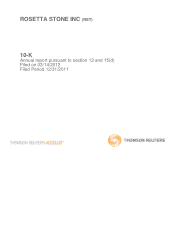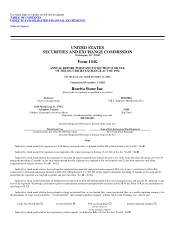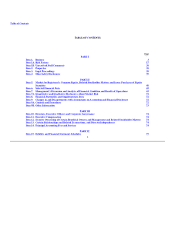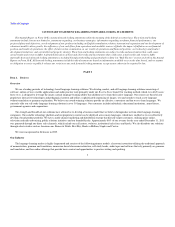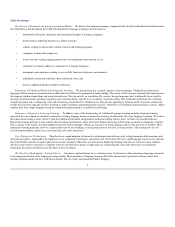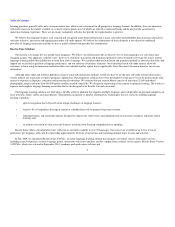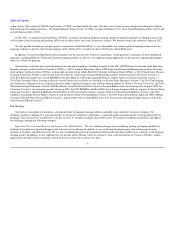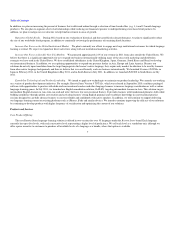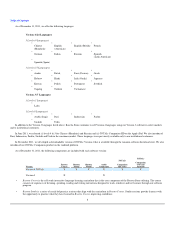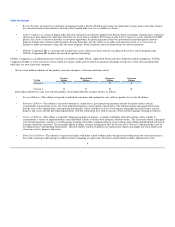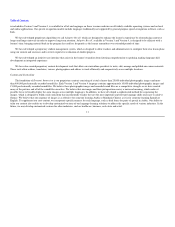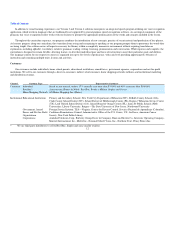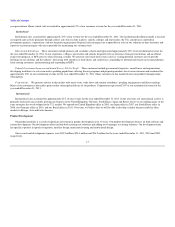Rosetta Stone 2011 Annual Report Download - page 6
Download and view the complete annual report
Please find page 6 of the 2011 Rosetta Stone annual report below. You can navigate through the pages in the report by either clicking on the pages listed below, or by using the keyword search tool below to find specific information within the annual report.
Table of Contents
Key Drivers of Demand in the Language-Learning Market. We believe that language learning is important and valued by individuals and institutions in
the United States and throughout the world. The demand for language learning is driven in part by:
individuals seeking the enjoyment and enrichment brought by learning a language;
professionals conducting business in a global economy;
schools seeking to educate their students in local and foreign languages;
companies training their employees;
leisure travelers seeking language proficiency for independent international travel;
armed forces training soldiers to communicate in foreign languages;
immigrants and expatriates seeking to successfully function in their new environments;
individuals connecting with their ethnic and family roots; and
parents supplementing their children's education.
Limitations of Traditional Methods for Language Learning. The human brain has a natural capacity to learn languages. Children learn their native
language without using rote memorization or adult analytical abilities for grammatical understanding. They learn at their own pace through their immersion in
the language spoken around them and using trial and error. They do not rely on translation. By contrast, foreign languages have traditionally been taught by
focusing on memorization, grammar translation and word translation, typically in an academic classroom setting. This traditional method involves learning
complex grammar rules, conjugating verbs and memorizing vocabulary lists. Students have little practice speaking or listening in the classroom, and practice
outside the classroom typically involves listening to audio recordings and pronunciation exercises, with little or no feedback on pronunciation accuracy. Many
students who were taught languages using the traditional method regard it as ineffective and boring.
Emergence of Immersion Language Learning. To address some of the shortcomings of traditional language-learning methods, language-learning
specialists have developed an alternative method for teaching language known as immersion learning, in which only the target language is spoken. We believe
that immersion learning is more effective than the traditional translation and grammar method in helping learners move towards conversational fluency.
Immersion learning provides a more natural, direct learning environment, where the learner deduces meaning and develops an intuition of language structure.
This is similar to the manner in which children learn their native language, without an awareness of formal grammar rules or the necessity to translate. Most
immersion learning programs, however, require either one-on-one teaching, a small group course or travel to a foreign country. These programs can cost
several thousand dollars and are less convenient than self-study alternatives.
Use of Interactive Technologies. There has been a rapid adoption of interactive technologies and software tools to help learning in both consumer and
institutional markets, supported by the rapid increase in computing technologies and internet use. Given busy lifestyles, adult language learners seek solutions
that work flexibly and do not require physical classroom attendance. Educators are interested in deploying learning tools that are relevant to their students,
who have had extensive exposure to computer software and interactive games. Corporations are recognizing the value and effectiveness of using their
technology investment to help increase the skills of their workforce.
The Need for a High-Quality, Trusted Solution. Consumers and institutions face a confusing array of alternatives when choosing a language course due
to the fragmented nature of the language-learning market. Most providers of language-learning offer little information to potential customers about their
teaching methods and do not have well known brands. The few major internationally known language
4
•
•
•
•
•
•
•
•
•

